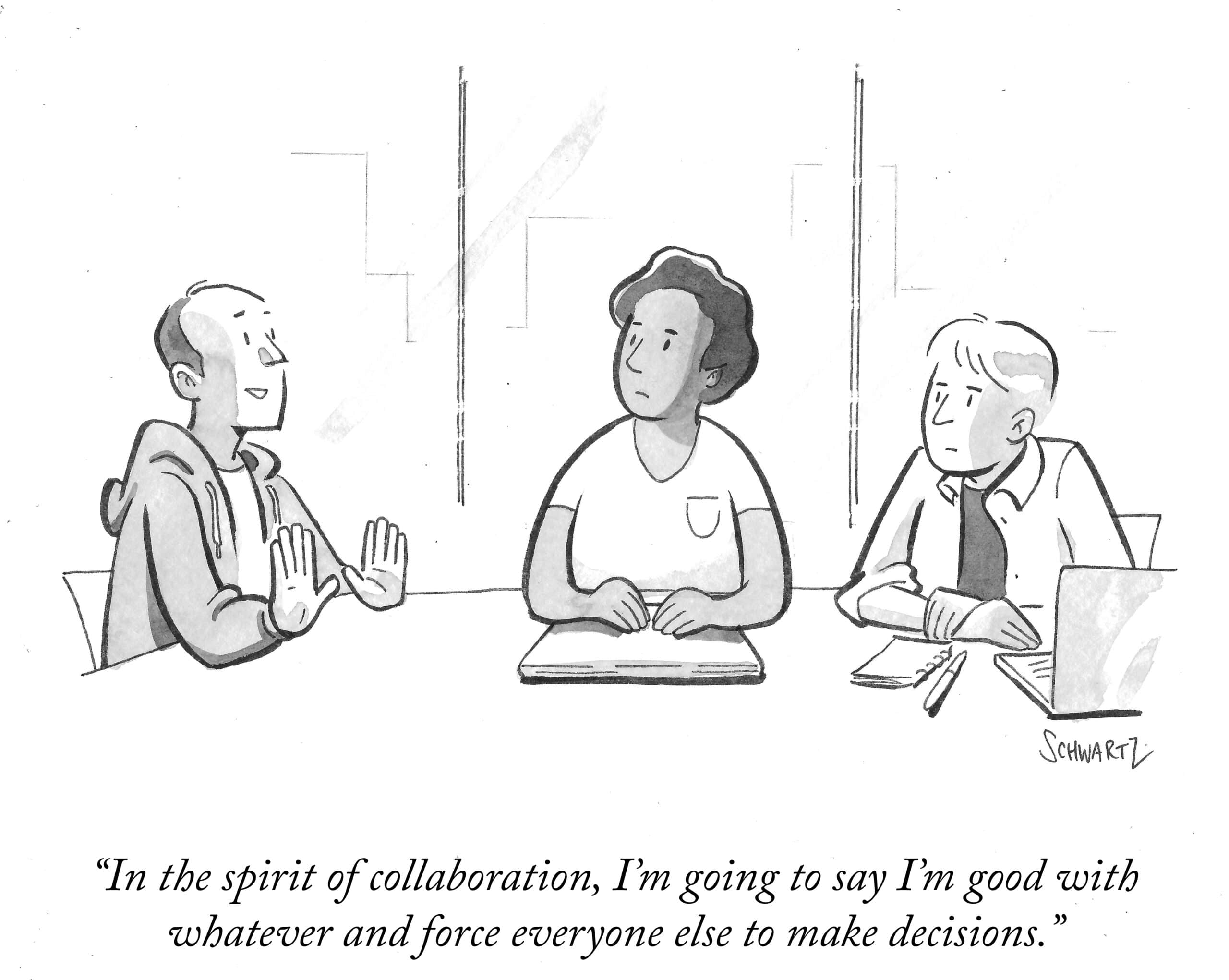Workplace trends
Gen Z doesn’t aspire to climb the corporate ladder
Unlike previous generations, which viewed management roles as a sign of career success, 72% of Gen Zers prefer to grow as individual contributors, according to recruitment firm Robert Walters. Experts say this shift doesn’t indicate a lack of ambition but rather a desire to become real experts in their domains and to avoid the responsibilities of managing others. The change in sentiment stems from various factors, including an increased desire for work-life balance and recent tech layoffs disproportionately affecting middle management. With one-third of 2023 layoffs targeting these positions, the trend of overworked managers facing job insecurity has deterred many young people from seeking a similar fate. Thus, Gen Z is increasingly drawn to individual contributor roles and entrepreneurship, with “founder” being the second fastest-growing job title among Gen Z college graduates on LinkedIn.
Defense-tech startups must rely on China, their adversary
With China serving as the primary supplier of essential components like batteries, sensors, and motors for U.S. defense companies, defense-tech startups face a critical dilemma: they rely on the very country they aim to counter. China’s abilities, and often, its desire to disrupt this supply chain, are leaving defense tech startups feeling increasingly vulnerable. This issue is particularly pressing as the defense industry gains popularity amid global uncertainties. In fact, hundreds of new U.S. defense-tech startups have raised over $130 billion from venture capitalists since 2021, according to PitchBook data. However, restructuring the supply chain requires resources and geopolitical expertise that most startups lack, leaving them in a precarious position.
The AI corner
AI is overburdening the US power grid
AI’s rapid expansion is driving an unprecedented surge in energy demand, with ChatGPT consuming up to 10 times more energy than a Google search. According to the Electric Power Research Institute, these data centers could account for an astonishing 9% of U.S. electricity use by 2030 – equivalent to the current combined electricity usage of all of New York and Texas. This growing demand has led to power supply shortages, prompting some utilities to pause new service requests for data centers. In California, Silicon Valley Power has stopped accepting these requests, while central Ohio’s largest power line is projected to reach capacity by 2028. This insatiable appetite for energy is straining existing infrastructure and raising critical questions about the sustainability of AI’s exponential growth and long-term environmental impact.
Regulating AI is proving very tricky
A California bill, poised to be the most comprehensive AI regulation effort to date, has been vetoed under pressure from Silicon Valley tech giants. The proposed legislation mandated safety testing for AI models requiring significant computing power and at least $100 million in training costs. However, opponents, primarily investors and executives, claimed that these requirements would be a radical threat to innovation. The rollback of regulations exemplifies the complex challenge governments worldwide face in regulating this advanced technology. While there’s consensus on the need for guardrails, the rapidly evolving nature of AI technology and the nuances of different AI models make the practical crafting and implementation of effective legislation incredibly tricky.
Uncovering hidden talent on your team
Research is pointing to a looming skills gap in today’s workplace, with 87% of companies saying they already have one or expect to soon, according to McKinsey. While much of the demand for new skills is fueled by technological innovations and the increasing presence of AI, organizational shifts are also playing a huge role in accelerating the need to upskill. 64% of surveyed managers say their employees were given additional job responsibilities in 2023, 51% said their teams were restructured, and 42% have had to adjust to budget cuts, according to a recent Gallup study.
Some companies are trying to close the skills gap by spending significant time and money bringing in new talent, while others are being forced to delay deadlines as a result of budget cuts and hiring freezes. Given that both scenarios slow productivity and momentum, it’s time for a mindset change. Rather than searching outside for new skill sets or simply waiting until you can increase your headcount, why not try unlocking the full potential of the talent you already have?
Your employees are dynamic individuals with strategic capabilities that may not come up in their everyday roles. As a leader, however, you have the unique opportunity to uncover these hidden skills, help your employees grow and develop, and increase productivity across your department.
So how do you go about finding these hidden talents and expanding the collective skill set on your team?
Do some digging
When one of your employees excels on a certain project, try to learn about their approach to problem-solving. Ask questions like “What was the greatest challenge in this project?” and “Can you walk me through how you navigated it?” Their answers might expose super valuable underlying skills. For example, if your team member used a certain design tool to effectively visualize and plan the process, it might indicate that they have a knack for visual storytelling. From there, you could start ideating ways for them to continue to exercise and expand that skill. Perhaps that means presenting their methods to the greater team or bringing the skill more directly to the next project.
Try to identify patterns
Pay attention to the types of tasks and processes your team members seem to gravitate towards to identify patterns or themes in skills. For example, you may come to find that certain team members enjoy organization-related projects, others may tend to get excited about exploring creative solutions, and some may really thrive when it comes to resource management. Try to understand why they are drawn to those activities, and help them find ways to put their passions into use in your upcoming projects.
Get to know your team
Your team members are well-rounded people, and it’s important to recognize that their work is only a small part of who they are. Try to take time to get to know each of your employees on a more personal level and find out what interests them outside of their careers. Maybe you’ll discover that your team member loves to do art at home, is a really dedicated parent, is training for a marathon, or has a whole host of other interests. And while seemingly unrelated, these nuggets of information can reveal creativity, discipline, leadership abilities, and passions that can be channeled into developing new skills and applied to your work as a team.
Find creative ways to uncover skills
When you oversee multiple people, it’s not always easy to discover each individual’s unique strengths outside of their day-to-day work, so here’s another idea: consider having each of your team members take a strengths-finder test, such as Gallup or Myers-Briggs. Go over the results of the test in your one-on-ones and ask deepening questions to uncover potential skill sets. Maybe you notice that your employees’ strength is “maximization,” or doing the most with limited resources. Ask them to reflect on that trait and identify times in which they managed to put it into practice either at your company or in a previous role. By hearing their thought processes, you might identify highly relevant and overlooked skills.
Set skills goals
73% of workers say skills-based practices would improve their experience at work, according to Deloitte, so be intentional about nurturing abilities. It’s not enough to identify a skillset and leave it up to chance that it will be used in a meaningful way. Instead, you need to ask your team members to set goals for developing that skill or talent further and finding new applications for it. With those who set career goals engaging with learning 4x more than those who don’t, per a LinkedIn Workplace Learning Report, it’s important to really invest in your team members’ skills development.
To sum it up
Skills are vital in shaping how organizations define work, deploy talent, manage careers, and value employees, according to 89% of the executives polled by Deloitte. That’s why great managers don’t just spot potential – they uncover hidden skills in their team members and provide opportunities for them to shine brighter. By doing this, you’re building a more dynamic, future-ready team from within – without having to look outside for the talent you need.
Water cooler chatter
A top Chinese economist vanished after criticizing the management of the economy. Zhu Hengpeng, who was the deputy director at a state-run Chinese Academy of Social Sciences, is the latest in a string of academics and business people who have been detained, imprisoned, or forced into exile after commenting on leader Xi Jinping’s leadership.
Disney+ is cracking down on password sharing. Following the lead of Netflix, Disney+ has begun informing subscribers of paid-sharing options, a move which comes less than a month before its US prices across platforms are set to increase.
Question of the week
Last week’s answer: 84 years and 9 days, Walter Orthmann, who worked for a Brazilian textile company
This week’s question: What is the average tenure at a company for an employee in the U.S.?
Just for laughs

Don’t miss more quality content!


